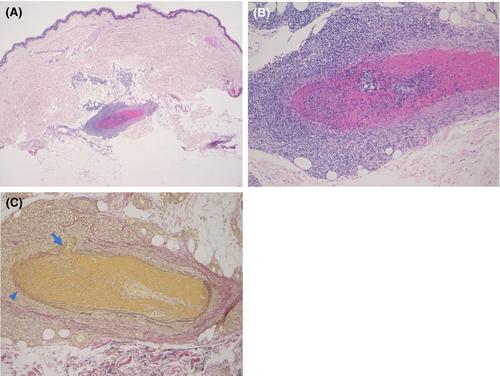Cutaneous arteritis: Clinicopathological study of 21 cases
Abstract
Objectives
We conducted this study to clarify the progress of cutaneous arteritis.
Methods
We examined 21 cases of cutaneous arteritis that were diagnosed at our hospital between 2005 and 2020. The male-to-female ratio was 1:6 with a mean age of 52.2 years.
Results
The lower legs were involved in all cases, and the upper extremities or trunk was also involved in some cases. Cutaneous manifestations presented as indurated erythema (n = 15), subcutaneous induration (11), edema (7), livedo (6), and ulcer (3). In addition, extracutaneous conditions including numbness (10), arthritis (8), fever (2), and myalgia (1) were observed. Laboratory tests showed an increase of inflammatory markers in most cases (14). Histopathological features showed necrotizing vasculitis of small-sized arteries at the dermo-subcutaneous junction, and the inflammatory stages of arteritis were histopathologically divided into acute stage (5), subacute stage (5), reparative stage (7), and healed stage (1). The therapies administered were oral prednisolone (11), antiplatelet drug (14), warfarin (1), non-steroidal anti-inflammatory drugs (6), biological drug (1), and other drugs (14). There were no cases showing progression to systemic polyarteritis nodosa during follow-up period. All three patients with ulceration complained of numbness, and one was revealed to have mononeuropathy multiplex. They were treated with low-dose oral prednisolone. Three ulceration cases were histopathologically classified into the acute and subacute stages.
Conclusions
In conclusion, all 21 patients followed a chronic course with recurrent skin lesions without systemic complications. Cases with ulceration seem to reveal neurological symptoms and need systemic steroid treatment.


 求助内容:
求助内容: 应助结果提醒方式:
应助结果提醒方式:


